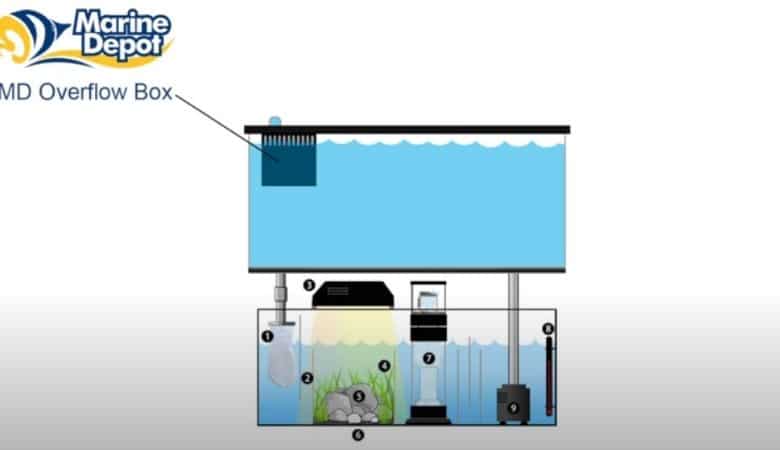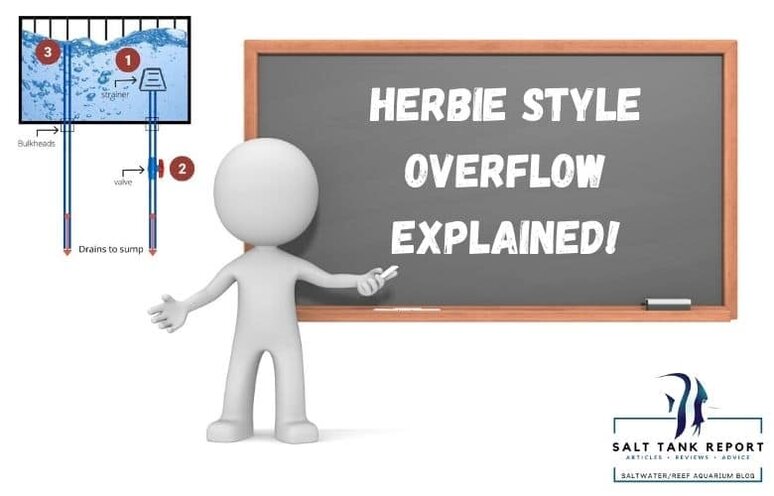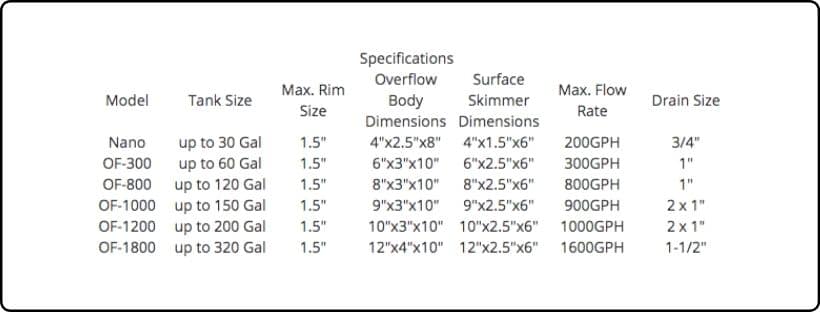In this guide, I will show you how to choose the right size overflow box for your saltwater tank.
An overflow box is used to siphon water from your display tank into a sump system.
If you are planning to use a sump on your tank, choosing the right overflow box can be confusing.
There are many factors to consider including size, flow rate, return pump, cost, and brand. The most common consideration is size.
An overflow box is not a necessary piece of equipment.
You can also use an internal overflow providing you are able to drill your tank. If your tank has tempered glass, you can not drill it.
The advantage of using an overflow box is it eliminates the need for drilling your tank.

How an aquarium overflow box works
The overflow box is designed to work by using suction to move water from your main tank into a sump.
The unique design prevents a suction loss in the event of a power outage by trapping water in the U shaped tube. The suction will start automatically when power is restored.
There have been many concerns about overflow boxes not starting back up causing water to overflow your main tank causing a flood.
This would happen if there was a siphon break by air entering the U tube. While this is very rare, it is a possibility that makes people nervous about using overflow boxes.
But the only way a flood can happen is if the overflow box is set up wrong and you don’t have the right fail-safes in place.
A properly set up overflow box should never fail and cause a flood. Overflow boxes are effective and work well when set up the proper way.
When a siphon is created, water will flow into your sump, through the filtration, and then pumped back into your main tank.
The rate of water flow being returned must match the overflow rate. So choosing the proper flow rate of the overflow box and return pump is very important.
What size overflow box do you need?
There are 2 main considerations when choosing the right overflow box for your tank.
The physical size of it and its flow rating.
The physical size is important as you want to make sure it will fit on the trim of your tank properly and there is enough room behind your tank if you have it placed against a wall.
Measure the distance between the wall and your tank to ensure the overflow box you are going to use has enough space to fit.
As an overflow box will sit on your tank trim, make sure that the rim of the tank is not too thick or the center bracing will not be in the way.
Many people are confused by how much flow to look for and how much flow they need to suit their tank.
The great thing about overflow boxes is they are self-regulating. This means that they won’t drain any more water than the amount that is put into it.
Think of it this way.
As long as the overflow box can handle the water flow from your return pump, it is the right size.
If your return pump will be pushing 800 GPH, make sure your overflow box can handle a minimum of 800+ GPH.
I recommend the overflow box be rated higher than the return pump.
In this case, a 1000 GPH overflow box would work well. Just make sure the overflow is rated for more than the return and you are all set.
Not the other way around. You don’t want more return flow than the box can handle.
Pro tip: Remember to take into consideration head height and plumbing to calculate the actual water flow rate from your return pump. Your return pump might be rated for 800 GPH, but only 500 GPH may be actually returned into the tank.
Choosing an aquarium overflow box
There are different manufacturers of overflow boxes to choose from. They are all pretty much the same.
Most are made with high-quality acrylic and include everything you need to use it right out of the box.
Smaller units will usually have a single U tube with a single standpipe drain.
Larger units will have dual U tubes with dual standpipe drains.
The advantage of using a dual drain is you have a backup drain in the event one were to become clogged.
My favorite type of overflow is the Herbie style method.
When set up properly using a dual standpipe overflow, the Herbie method is perfectly silent, easy to set up, and fail-proof.

Best overflow boxes
Marine Depot Overflow boxes
The Marine Depot overflow boxes are available in many sizes and will suit aquariums from a nano 30 gallon up to a 320 gallon.
They are designed with high-quality materials, easy to set up, and are quiet.

Eshopps overflow boxes
Eshopps overflow boxes are very similar to the Marine Depot boxes. The surface skimmer box has a different design, but both work well.
I have been using an Eshopps PF-1000 on my 120-gallon tank for years with no issues.
Eshopps overflow boxes are available on Amazon here.
Summary
When choosing the right size overflow box for your reef tank, the most important thing is to ensure the rating of the overflow is more than the return pump flow.
Because the overflow box is self-regulating, it will automatically match the return pump flow unless it is more than it can handle.
Once you choose the right size for your tank and set it up properly, overflow boxes are very convenient and work well for people who do not have the option of a drilled tank with an internal overflow.
